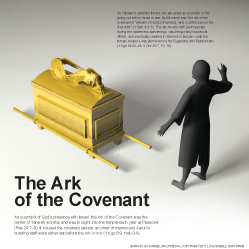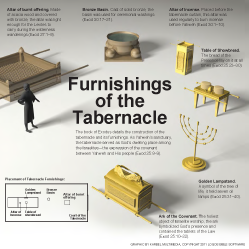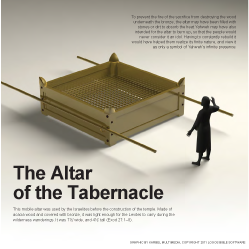31:1–11 This passage begins with Yahweh telling Moses whom He has chosen to carry out the work of constructing the tabernacle and all its furnishings. The skilled workers mentioned in this passage, Bezalel and Oholiab, design the individual pieces, teach others, and oversee the labor (see 35:30–36:2). This passage also includes a catalog of all that they are commanded to manufacture. |
31:2 I have called by name God has commissioned these specific men for this task.
Bezalel This name may date back to the patriarchal era, since it contains the more ancient name of God (el) rather than the more recent covenant name (Yahweh). “Bezalel” means “in the shadow of (i.e., under the protection of) El.”
Uri The name, meaning “my light,” is probably an abbreviated form of a longer name that contained a reference to a deity name (called the theophoric element). The full name may have been Uriel (“El is my might”) or Uriah (“Yah[weh] is my light”).
31:3 the Spirit of God In the ot, specific skills or tasks are often associated with divine enablement. Heightened wisdom in any given area was viewed as coming from God, the source of all wisdom.
31:6 Oholiab Means “(the) father is my tent,” referring to protection or security. It may have an intended word play involving the tent of meeting, since Oholiab is in charge of building it (v. 7; compare 27:21; 28:43).
the tribe of Dan The tribe of Dan is elsewhere referred to in unflattering terms. See note on Gen 30:6.
31:7 the tent of assembly The relationship between the tent of meeting and the tabernacle is not clear. See Exod 27:21 and note.
ark See note on 25:10. The Hebrew word used here, aron, refers to a storage box of varying size, but it is commonly used for the “ark of the covenant,” which symbolized Yahweh’s presence among the Israelites.
which symbolized Yahweh’s presence among the Israelites.
atonement cover The lid of the ark of the covenant. See note on 25:17.
31:8 table See note on 25:23–30.
the incense altar See note on 30:1–10.
31:9 the altar of burnt offering The main sacrificial altar in the courtyard of the tabernacle (see 27:1–8 and note).
in the courtyard of the tabernacle (see 27:1–8 and note).
basin The priests washed their hands and feet in this before entering the holy place. See 30:17–21 and note.
31:10 the garments of woven material Described in ch. 28 and 39.
31:12–18 This passage deals with the observance of the Sabbath. It is actually the seventh literary section describing the tabernacle and its personnel. The patterns of seven—reflecting the creation week—is deliberate: In six units God describes the work, and on the seventh He describes the Sabbath rest (v. 17; compare 16:23; 20:8; 23:12). The tabernacle narrative resumes in ch. 35 with the explanation of the Sabbath laws in abbreviated form (35:1–3). |
31:13 Sabbaths The plural here denotes the weekly observance in perpetuity. Its observance is the fourth of the commandments in 20:8–11 (compare 23:12; 31:15–17; 34:21). The principle of the Sabbath is established at creation (see Gen 2:2).
is established at creation (see Gen 2:2).
a sign This connects the Sinai covenant with the Abrahamic covenant, where circumcision is given as a sign (see Gen 12:1–3; 15:1–6; 17:1–14). The Sinai covenant is now at the same level as the Abrahamic; they operate in tandem and are to be honored equally (see Exod 24:3).
with the Abrahamic covenant, where circumcision is given as a sign (see Gen 12:1–3; 15:1–6; 17:1–14). The Sinai covenant is now at the same level as the Abrahamic; they operate in tandem and are to be honored equally (see Exod 24:3).
31:14 defilers of Refers to treating something holy as though it were common or ordinary.
will be cut off from among his people The proximity of this phrase with the reference to being put to death suggests it may sometimes indicate capital punishment. It generally means shunning or exclusion from the covenant community and its blessings. See note on Num 15:30.
31:17 the seventh Here, the Sabbath serves as a commemoration of Yahweh creating the world in six days and resting on the seventh (Gen 2:2). This both connects the Sabbath observer to Yahweh, and reminds Israel of its status as cocreators with him (Gen 1:27–30). In Deut 5:15, the Sabbath is in remembrance of the bondage in Egypt.
31:18 the two tablets of the testimony Refers to the commandments of Exod 20 (commonly called the Ten Commandments), which were written on the two tablets (see 24:12–18).
the finger of God This reference contributes to understanding the nt references to the law having been dispensed by angels (Acts 7:38, 53; Gal 3:19; Heb 2:2).

|
About Faithlife Study BibleFaithlife Study Bible (FSB) is your guide to the ancient world of the Old and New Testaments, with study notes and articles that draw from a wide range of academic research. FSB helps you learn how to think about interpretation methods and issues so that you can gain a deeper understanding of the text. |
| Copyright |
Copyright 2012 Logos Bible Software. |
| Support Info | fsb |
 Loading…
Loading…





